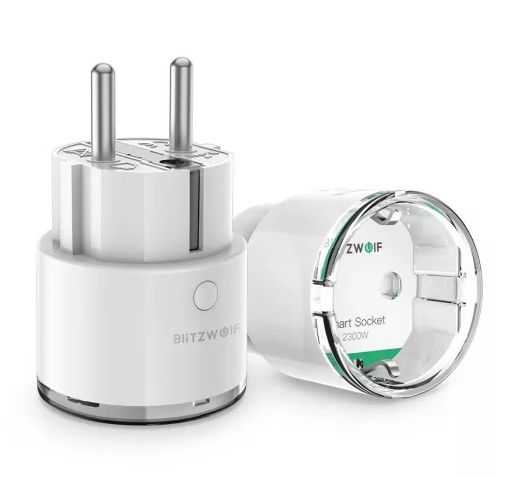devices.esphome.io
Blitzwolf BW-SHP6 Socket with powermonitoring
Blitzwolf BW-SHP6 Socket with powermonitoring
Device Type: plugElectrical Standard: euBoard: esp8266
General Notes
Model reference: BW-SHP6
Manufacturer: BlitzWolf
There are two versions of this plug, a 10A version and a 15A version. The pinout seems to be the same.

GPIO Pinout
| Pin | Function (<2020) | Function (>2020) |
|---|---|---|
| GPIO0 | Red LED (inverted) | Red LED (inverted) |
| GPIO2 | Blue LED (inverted) | Blue LED (inverted) |
| GPIO4 | HLW8012 - CF1 | |
| GPIO5 | HLW8012 - CF | HLW8012 - CF |
| GPIO12 | HLW8012 - SEL | HLW8012 - SEL |
| GPIO13 | Button (inverted) | Button (inverted) |
| GPIO14 | HLW8012 - CF1 | |
| GPIO15 | Relay | Relay |
HLW8012 Calibration Values
| Value | <2020 | >2020 |
|---|---|---|
| Current | 0.00290 | 0.00117 |
| Voltage | 940 | 755 |
Basic Config
The configuration has some default sensors for wifi reporting, etc.
substitutions: device_name: shp6 # Higher value gives lower watt readout current_res: "0.00290" # Lower value gives lower voltage readout voltage_div: "940" # Max Power is 3450W for 15A and 2300W for 10A max_power: "3450" # 2020 model uses GPIO4 for CF1 cf1_pin: GPIO14 # BW-SHP6, outlet with powermonitoring. # One button for the relay, and one red led for the relay, as well as a blue status led # Static IP is configured, and fast_connect is enabled, as the SSID is hidden # Webserver is active and pw protected, and the OTA is password protected
esphome: name: "${device_name}" on_boot: then: - switch.turn_on: relay - output.turn_on: led
esp8266: board: esp8285
wifi: ssid: !secret wifi_ssid password: !secret wifi_password ap:
logger: baud_rate: 0
api:
ota: password: !secret otapw
# Button configurationbinary_sensor: - platform: gpio name: "${device_name} button" id: button pin: number: GPIO13 inverted: true on_press: then: - switch.toggle: relay
# Setup of LED's used in displaying Switch statusoutput: - platform: gpio pin: GPIO0 inverted: true id: led
# Config for switchswitch: - platform: gpio pin: GPIO15 restore_mode: RESTORE_DEFAULT_OFF id: relay name: "${device_name} Relay" on_turn_on: - output.turn_on: led on_turn_off: - output.turn_off: led
# Status LED for connectionstatus_led: pin: number: GPIO2 inverted: true
# Sensors for Voltage (V), Current (A), Power (W), Daily energy usage (kWh)sensor: - platform: hlw8012 sel_pin: number: GPIO12 inverted: true cf_pin: GPIO5 cf1_pin: ${cf1_pin} current_resistor: ${current_res} voltage_divider: ${voltage_div} current: name: "${device_name} Current" unit_of_measurement: "A" accuracy_decimals: 3 icon: mdi:flash-outline voltage: name: "${device_name} Voltage" unit_of_measurement: "V" icon: mdi:flash-outline power: name: "${device_name} Power" unit_of_measurement: "W" id: power icon: mdi:flash-outline on_value_range: - above: ${max_power} then: - output.turn_off: led - switch.turn_off: relay change_mode_every: 4 update_interval: 10s - platform: total_daily_energy name: "${device_name} daily energy" power_id: power unit_of_measurement: "kWh" accuracy_decimals: 5 filters: - multiply: 0.001Advanced config additions
Starting with ESPHome v1.16.1 the hlw8012 platform sensor now supports energy, so we can add the following to the hlw8012 platform sensor and get rid of the total_daily_energy platform sensor and the homeassistant time sensor:
sensor: - platform: hlw8012 energy: name: "${device_name} Energy" unit_of_measurement: "Wh" icon: mdi:flash-outlineUnder wifi this can be added, this will set up static IP, allow the device to connect to a hidden SSID (fast_connect) and create a backup AP
wifi: reboot_timeout: 60min manual_ip: static_ip: 192.168.1.100 gateway: 192.168.1.1 subnet: 255.255.255.0 fast_connect: true
# Enable fallback hotspot (captive portal) in case wifi connection fails ap: ssid: "${device_name} Hotspot" password: !secret appwThis will activate the internal webserver with password protection
web_server: port: 80 auth: username: !secret webuser password: !secret webpwTo set time locally to the same as on the HomeAssistant (better logging)
# Sets time from Homeassistanttime: - platform: homeassistant id: homeassistant_timeSend a notification to Home Assistant when max power is exceeded.
sensor: - platform: hlw8012---power: name: "${device_name} Power" unit_of_measurement: "W" id: power icon: mdi:flash-outline on_value_range: - above: ${max_power} then: - output.turn_off: led - switch.turn_off: relay - homeassistant.service: service: persistent_notification.create data: title: Message from ${device_name} data_template: message: Switch turned off because power exceeded ${max_power}WTo have different data shown for the device (ESPHome version) and the wifi. Will appear as sensors in HA.
# Sensors for ESP version and WIFI informationtext_sensor: - platform: version name: "${device_name} ESPHome Version" - platform: wifi_info ip_address: name: "${device_name} ip" ssid: name: "${device_name} ssid"This will create sensors so that you can track wifi coverage for the devices, and also note the uptime for the devices.
sensors: - platform: wifi_signal name: "${device_name} WiFi Signal" update_interval: 60s accuracy_decimals: 0 - platform: uptime name: "${device_name} Uptime" unit_of_measurement: days update_interval: 300s accuracy_decimals: 1 filters: - multiply: 0.000011574